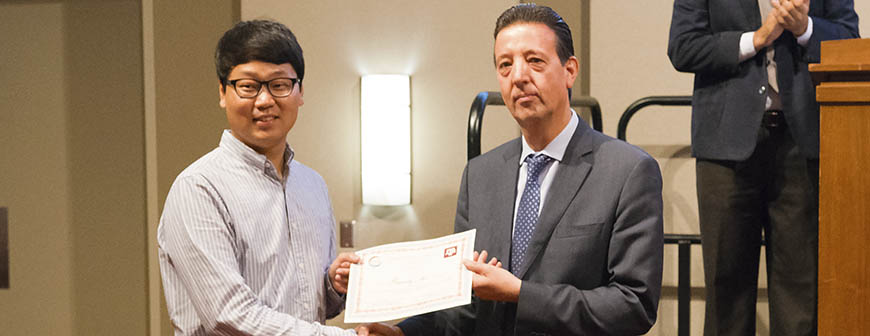
Hyosung An (pictured above), Ph.D. candidate in The Artie McFerrin Department of Chemical Engineering at Texas A&M University, won the award for the best oral presentation in the Energy Storage Technologies category at the Inaugural Texas A&M Conference on Energy, the brainchild of late Christodoulos A. Floudas. The conference was organized by the Texas A&M Energy Research Society with the support of the Texas A&M Energy Institute.
The presentation, “Highly Flexible Self-Assembled V2O5 Cathodes Enabled by Conducting Diblock Copolymers,” beat out nine other presentations in the Energy Storage Technologies category. An’s presentation is the result of nearly three years of polymer research with his Ph.D. adviser Dr. Jodie Lutkenhaus, associate professor in chemical engineering and holder of the William and Ruth Neely Faculty Fellowship.
As part of a National Science Foundation Grant, Hyosung and Lutkenhaus have developed a novel electrode, a cathode in this case, that allows for the construction of a flexible battery.
Currently, electrodes in lithium ion batteries are composed of rigid materials that store lithium ions in between paper-like layers. However, the rigid geometry of the electrodes limits them in terms of possible applications. Further owing to the rigidity, the energy capacity of current electrodes is directly proportional to their size. There has been some research towards different, higher-capacity, more elastic materials in electrodes, but they are plagued with short lifecycles; the higher capacity materials such as silicon and, in this case vanadium pentoxide (V2O5), expand and contract with each cycle, causing them to become brittle and prone to mechanical failure.
While not currently used in consumer lithium ion batteries, V2O5 is an appealing candidate for electrodes as it is inexpensive and has a very high energy density. However, V2O5 is prone to mechanical failures. Further, it is also limited by relatively poor conductivity. To counteract these issues, researchers have begun to incorporate polymers into the electrode design. To date, however, researchers have been forced to do a tradeoff, either increasing the mechanical properties and decreasing the conductivity or vice versa.
“There has been work towards incorporating a polymer into the battery system,” said An. “Some improved the mechanical properties, but the electrochemical performance was poor. Other research has achieved a high electrochemical performance, but most did not show any mechanical improvement, or simply did not test mechanical performance.”
Herein lies the problem, to find the right polymer that would increase both the mechanical and electrochemical properties of the electrode. An and Lutkenhaus were able to do just that, somewhat serendipitously.
“When we started working on this, our original goal was to enhance the electrochemical properties,” said Lutkenhaus. “With the right polymer, the electrode becomes more conductive and offers better performance. Hyosung came to me and said, ‘It’s also more flexible.’”
Added An, “by using conducting diblock co-polymers we balanced both, achieving high mechanical performance and high electrochemical performance.”
These new electrodes are much more than adequate. In fact, in a single component analysis, the new cathode is fundamentally better than what is used now. This is on top of its added mechanical flexibility.
“The cathode you have right now is probably doing around 120-140 mAh/g and what Hyosung is showing is about 200 mAh/g,” said Lutkenhaus. “So it is substantially better.”
This work has already led to a wide variety of accolades, in addition to An winning the award for the best oral presentation, he was a finalist in this year’s Raymond Ideas Challenge sponsored by the Texas A&M University Center for New Ventures and Entrepreneurship. An and Lutkenhaus have published papers in ACS Appl. Mater. Interfaces, and Scientific Reports.
An’s Ph.D. program is supported by a scholarship from the Kwanjeong Educational Foundation.